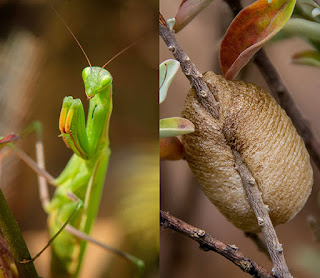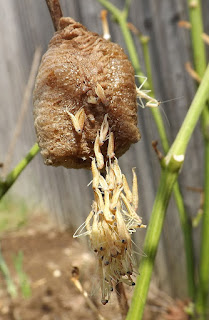WHAT’S AN OOTHECA?
Praying mantids have a fairly simple life cycle, especially for an insect: Adults grow and eat from late spring through the summer, then they mate and females lay their eggs in an egg case in the fall. The egg case is called an ootheca and it begins as a white, foamy mass that hardens into a fibrous brown case resembling a walnut. After mating and producing the oothecas, the adults will die of old age or cold. The eggs, however, will snuggly overwinter inside their case until warmer weather sends the cue for them to emerge as nymphs. These nymphs look like tiny adults and those that survive (about 1/5th of them) will grow rapidly. For more on all of this, check out this article, and here’s a video of a mantis laying her eggs.
WHERE DO WE GET THE OOTHECAS?
The oothecas we sell are gathered in the wild in and around the Allegheny Mountains (which straddle Ohio, West Virginia, Maryland, and Virginia). We work with people who have been picking for many years – some more than 30 years. These are people who take great pains to safeguard this valuable resource, not only because they depend on the revenue year after year, but because they do their picking in their homelands.
WHAT KIND OF PRAYING MANTIDS ARE IN MY OOTHECA?
Although there are three main species of mantids found in North America (Carolina, European, and Chinese), the Carolina is the only one that is native to our continent. However, these are not the predominant species found in the area where we get our oothecas. The egg cases we have are Chinese mantids, with a Carolina appearing every now and then. You can tell the difference by their shape – the Chinese ootheca is round, while the Carolina is longer and more oblong or rectangular-shaped. If you want more on identifying between the species, this article has some excellent tips and pictures.
AREN’T CHINESE MANTIDS INVASIVE?
Many people consider the Chinese mantid invasive, and it inarguably was at one point. However, now that they have been in North America for at least a century, they have become naturalized in the region that we are supplied from. They have dominated (and most likely eaten) the native species, causing them to decline, but otherwise have caused no harm to existing ecosystems.
HOW MANY ARE EGGS ARE IN A CASE?
The best answer for this is would be “Who knows?" because the number is hugely variable and dependent on things like weather conditions and species. There’s simply no way to determine what’s going on in there until they hatch. There may be as few as a handful or more than 300, but 50-200 is a safe bet. The size of the ootheca in no way determines the number of eggs inside; in many cases, the smaller ones will produce more nymphs than larger ones.
WHERE DO I KEEP MY OOTHECA?
They can be kept indoors or outdoors, but we recommend indoor hatching so they are less vulnerable to predators and the weather. You can keep the ootheca in the vial it comes in, but if you have more than one you’ll probably want to separate them. They do not need a lot of air, a simple, tight (but non-airtight) lid will do; if you do poke holes in a lid, make sure they are tiny. Observe your ootheca closely and often. The emerging mantids will need to be released as soon as they start hatching or they will begin to eat each other. Once you see the hatching, take them to your desired release area and sprinkle them out. You can leave the egg case outside in the event that there are still some mantids inside waiting to hatch.
WHEN WILL MY OOTHECA HATCH?
This is another mystery that only Nature is sure of. In the wild, hatching is all about the seasonal change in temperature. When you purchase an egg case, you have a little more control in when they hatch. To keep them in a dormant stage, store them around 41° (no lower) until you are sure warmer weather is arriving. At that time, keep them between 60-80°F (no higher) and they should hatch in 2-6 weeks. Here are two tips to get them to hatch faster from our Bug Wrangler, Christina, who handles many, many oothecas every year: Keep them right at the 80°F mark and hang them pointy-side down.
IT’S BEEN WEEKS AND MY OOTHECA STILL HASN’T HATCHED, WHY NOT?
Some cases will hatch fast and some take more time. If you order more than one case, the oothecas you will receive will come from the same location/picker, which means they should hatch close to the same time. So, if one has hatched the other(s) should follow fairly close behind. If you are hatching outside, it is easy to mistake a hatched and abandoned case for an unhatched one. When hatching, the nymphs push out between fibers in the case, which will then close up behind them and leave no evidence of their departure. There is also the simple truth that sometimes an oothecal is not viable.WHAT WILL THE MANTIDS EAT?
The nymphs will eat each other if they’re not released into the wild. This is the reason that you must monitor your egg cases regularly for hatching and release them when it happens. However, if you want to observe them for a while, you can hold them for a day or two, but it's risky. Mantids in general will eat anything that moves and that they can kill. This includes beneficial insects and pollinators. Don’t release desirable insects into an area where you have previously released mantids. This eye-opening video shows just how bold they can be in search of a meal. They even eat murder hornets - watch the video here.Take Care
Submitted by Pam












No comments:
Post a Comment